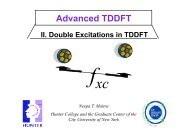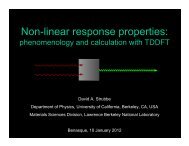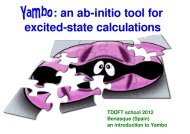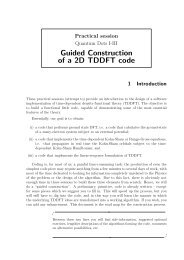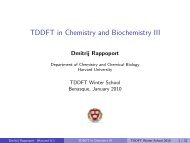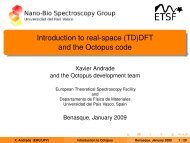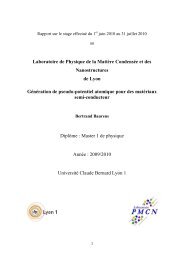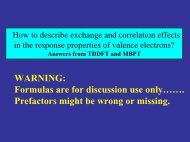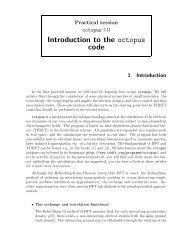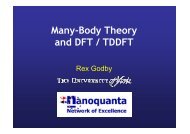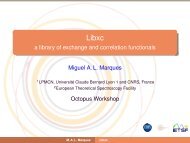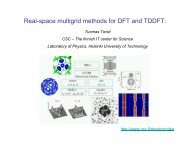Inverse quantum confinement in luminescent Silicon ... - TDDFT.org
Inverse quantum confinement in luminescent Silicon ... - TDDFT.org
Inverse quantum confinement in luminescent Silicon ... - TDDFT.org
Create successful ePaper yourself
Turn your PDF publications into a flip-book with our unique Google optimized e-Paper software.
<strong>Inverse</strong> <strong>quantum</strong> <strong>conf<strong>in</strong>ement</strong> <strong>in</strong> lum<strong>in</strong>escent<strong>Silicon</strong> <strong>quantum</strong> dotsThomas NiehausBremen Center for Computational Materials ScienceElectron Dynamics <strong>in</strong> Complex Systems4th Time-Dependent Density-Functional Theory:Prospects and ApplicationsBenasque – January 2010Thomas Niehaus, <strong>TDDFT</strong> Benasque 2010 1 of 46
Outl<strong>in</strong>e1 Motivation2 Theoretical MethodsApproximate <strong>TDDFT</strong> ⇒ TD-DFTB3 Application to <strong>Silicon</strong> NanostructuresHydrogenated SiQD - Simple and bor<strong>in</strong>g?Functionalization of Dots - Mak<strong>in</strong>g them usefulSurface reconstruction - Energetics and Spectra<strong>Silicon</strong> nanowires - Conf<strong>in</strong>ement <strong>in</strong> radial and axial dimensions4 Summary and OutlookThomas Niehaus, <strong>TDDFT</strong> Benasque 2010 3 of 46
What is a Quantum Dot?CharacteristicsAn object that conf<strong>in</strong>eselectrons <strong>in</strong> all three dimensionsMade mostly fromsemiconductor material.Extension of nanometersElectronic level spac<strong>in</strong>gcomparable k B TThomas Niehaus, <strong>TDDFT</strong> Benasque 2010 4 of 46
Properties of Quantum Dots – Size dependent EmissionFluorescence of Cadmium SelenideQuantum Dotswww.chemie.uni-hamburg.de/pc/weller/Range of Emission WavelengthMichalet Science (2005)Thomas Niehaus, <strong>TDDFT</strong> Benasque 2010 5 of 46
Properties of Quantum Dots – Advantages over DyesDyeMouse <strong>in</strong>test<strong>in</strong>al sectionhttp://probes.<strong>in</strong>vitrogen.comDotMulti-color labell<strong>in</strong>gpossibleThomas Niehaus, <strong>TDDFT</strong> Benasque 2010 6 of 46
Properties of Quantum Dots – Advantages over DyesMed<strong>in</strong>tz, Nature Materials (2005)top: Nucleus labelled with Dot, microtubules with Dyebottom: vice versaQuantum dots show only limitedphotobleach<strong>in</strong>gThomas Niehaus, <strong>TDDFT</strong> Benasque 2010 7 of 46
Quantum dots as markers <strong>in</strong> biologyIn vitroIn vivoFunctionalization withantibodies or aptamersMouse cerebellumhttp://probes.<strong>in</strong>vitrogen.comRat tumorGao, Science (2004)Thomas Niehaus, <strong>TDDFT</strong> Benasque 2010 8 of 46
Biocompatibility of Cadmium based DotsThomas Niehaus, <strong>TDDFT</strong> Benasque 2010 9 of 46
<strong>Silicon</strong> ???Bulk <strong>Silicon</strong>phonon assisted emissionfund. band gap of 1.13 eVThomas Niehaus, <strong>TDDFT</strong> Benasque 2010 10 of 46
<strong>Silicon</strong> ???Bulk <strong>Silicon</strong>phonon assisted emissionfund. band gap of 1.13 eV<strong>Silicon</strong> Quantum DotsDipole-allowed transitionBright emission <strong>in</strong> the visibleEmission from SiH nanoparticles underUV excitation, Belom<strong>in</strong> APL (2002)Thomas Niehaus, <strong>TDDFT</strong> Benasque 2010 10 of 46
Outl<strong>in</strong>e1 Motivation2 Theoretical MethodsApproximate <strong>TDDFT</strong> ⇒ TD-DFTB3 Application to <strong>Silicon</strong> NanostructuresHydrogenated SiQD - Simple and bor<strong>in</strong>g?Functionalization of Dots - Mak<strong>in</strong>g them usefulSurface reconstruction - Energetics and Spectra<strong>Silicon</strong> nanowires - Conf<strong>in</strong>ement <strong>in</strong> radial and axial dimensions4 Summary and OutlookThomas Niehaus, <strong>TDDFT</strong> Benasque 2010 11 of 46
Solution strategies <strong>in</strong> <strong>TDDFT</strong>Time doma<strong>in</strong>Frequency doma<strong>in</strong>i ∂ ∂t φ i(r, t) =[− 1 ]2 ∇2 + v KS [ρ](r) φ i (r, t)∑Ω ijkl Fkl I = ωI2klF Iij◮ Valid for strong fields◮ Full spectrum at once◮ Only occ. orbitals required◮ No <strong>in</strong>formation on darkstatesFormally N 3 , can be made N◮ Detailed <strong>in</strong>formation on theexcited state◮ S<strong>in</strong>glet and Triplet◮ Both occ. and virt. orbitalsrequiredFormally N 6 , can be made N 3Thomas Niehaus, <strong>TDDFT</strong> Benasque 2010 12 of 46
Density Functional based Tight B<strong>in</strong>d<strong>in</strong>g (DFTB)Ma<strong>in</strong> approximations - Ground stateM<strong>in</strong>imal AO basis: ψ i (r) = ∑ µ c µiφ µ (r − R A )Density divided <strong>in</strong>to reference density (ρ 0 ) and fluctuation:ρ = ρ 0 + δρTotal energy:E tot = ∑ i∑c µi Hµν[ρ 0 0 ]c νi + ∑ γ AB ∆q A ∆q B + U repµνABTwo-center approximation, matrix elements calculated not fittedγ AB represents e-e <strong>in</strong>teraction (<strong>in</strong>clud<strong>in</strong>g xc)Variational pr<strong>in</strong>ciple yields molecular orbitals and energiesSeifert et al. Z. Phys. Chem. 267 529 (1986) Elstner et al. PRB 58 7260 (1998)Thomas Niehaus, <strong>TDDFT</strong> Benasque 2010 13 of 46
DFTB approximation of <strong>TDDFT</strong> = TD-DFTB..jiEquation to solve (S<strong>in</strong>glets):∑kl[ω2ij δ ik δ jl + 2 √ ω ij K ij,kl√ωkl]FIkl = ω 2 I F IijCoupl<strong>in</strong>gmatrix K leads to correction of s<strong>in</strong>gle-particle picture∫∫DFT: K ij,kl = 2( 1ψ i (r) ψ j (r)|r − r ′ | + δv )xc(r)δρ(r ′ ψ k (r ′ ) ψ l (r ′ ) drdr ′)Niehaus, PRB 63 085108 (2001)Thomas Niehaus, <strong>TDDFT</strong> Benasque 2010 14 of 46
DFTB approximation of <strong>TDDFT</strong> = TD-DFTB.jiEquation to solve (S<strong>in</strong>glets):∑kl[ω2ij δ ik δ jl + 2 √ ω ij K ij,kl√ωkl]FIkl = ω 2 I F Iij.Get s<strong>in</strong>gle particle energies {ɛ i } from DFTBCoupl<strong>in</strong>gmatrix K leads to correction of s<strong>in</strong>gle-particle picture∫∫DFT: K ij,kl = 2DFTB: K ij,kl = 2 ∑ AB( 1ψ i (r) ψ j (r)|r − r ′ | + δv )xc(r)δρ(r ′ ψ k (r ′ ) ψ l (r ′ ) drdr ′)q ij Aγ AB (|R A − R B |, U A , U B ) q klBNiehaus, PRB 63 085108 (2001)Thomas Niehaus, <strong>TDDFT</strong> Benasque 2010 14 of 46
TD-DFTB performanceExcitation energies (eV)Molecule State Exp.TD-DFTB <strong>TDDFT</strong> 1ω I ω ij ω I ω ijEthylen 3 B 1u (π → π ∗ ) 4.40 5.47 6.30 4.16 5.661 B 1u (π → π ∗ ) 7.65 7.81 6.30 7.44 5.66Propynal 3 A ′′ (n → π ∗ ) 2.99 4.04 4.04 2.74 3.151 A ′′ (n → π ∗ ) 3.56 4.04 4.04 3.37 3.15[1] BPW91//6-311+G**Thomas Niehaus, <strong>TDDFT</strong> Benasque 2010 15 of 46
TD-DFTB performanceExcitation energies (eV)Molecule State Exp.TD-DFTB <strong>TDDFT</strong> 1ω I ω ij ω I ω ijEthylen 3 B 1u (π → π ∗ ) 4.40 5.47 6.30 4.16 5.661 B 1u (π → π ∗ ) 7.65 7.81 6.30 7.44 5.66Propynal 3 A ′′ (n → π ∗ ) 2.99 4.04 4.04 2.74 3.151 A ′′ (n → π ∗ ) 3.56 4.04 4.04 3.37 3.15[1] BPW91//6-311+G**Mean absolute error (eV)BPW91TD-DFTB 6-311+G** STO-3GINDO/SS<strong>in</strong>g. (16 Com.) 0.38 0.36 1.19 0.56Trip. (13/11 Com.) 0.64 0.37 0.49 1.38Thomas Niehaus, <strong>TDDFT</strong> Benasque 2010 15 of 46
Numerical issuesSum of CPU times (ground + excited state) for test set of 10 <strong>org</strong>anicmolecules (< 10 atoms). <strong>TDDFT</strong> results are for the BPW91 functional.1e+041e+03CPU time [s]1e+02101TD-DFTB INDO/S STO-3G 6-311+G**Thomas Niehaus, <strong>TDDFT</strong> Benasque 2010 16 of 46
Numerical issuesScal<strong>in</strong>gIterative subspace methods for diag.Formal scal<strong>in</strong>g of N 6 reduced to N 3∑Ω ij,kl v kl =klωijv 2 ij + 4 √ ∑ω ij qµ( ∑ ijµ νγ µν( ∑ klq klν√ωkl v kl ))CPU time [s]1010101054323.293.30EXC. STATEEXC. ST. GRADIENTGROUND STATE2.92Analytical excited state gradients from auxiliary Lagrangianapproach (Furche and Ahlrichs)⇒ Her<strong>in</strong>ger et al. JCC 28 2589 (2007)500 1000# basis functionsThomas Niehaus, <strong>TDDFT</strong> Benasque 2010 17 of 46
Outl<strong>in</strong>e1 Motivation2 Theoretical MethodsApproximate <strong>TDDFT</strong> ⇒ TD-DFTB3 Application to <strong>Silicon</strong> NanostructuresHydrogenated SiQD - Simple and bor<strong>in</strong>g?Functionalization of Dots - Mak<strong>in</strong>g them usefulSurface reconstruction - Energetics and Spectra<strong>Silicon</strong> nanowires - Conf<strong>in</strong>ement <strong>in</strong> radial and axial dimensions4 Summary and OutlookThomas Niehaus, <strong>TDDFT</strong> Benasque 2010 18 of 46
Generation of modelsSpherical fragments Si 1−199from bulk SiPassivation with Hydrogen andrelaxationSi-Si bonds 2.33-2.38 ÅT d symmetryd(Si 5 ) = 0.45 nm to d(Si 199 ) =2.0 nmThomas Niehaus, <strong>TDDFT</strong> Benasque 2010 19 of 46
Validation of TD-DFTBS 1 − S 0 energy [eV]DFTB PBE B3LYP MR-MP2 expSiH 4 10.3 8.76 9.25 8.8Si 5 H 12 6.40 6.09 6.66 6.56 6.5Si 29 H 36 4.42 3.65 4.52 4.45Si 35 H 36 4.37 3.56 4.42 4.33Thomas Niehaus, <strong>TDDFT</strong> Benasque 2010 20 of 46
Validation of TD-DFTBS 1 − S 0 energy [eV]DFTB PBE B3LYP MR-MP2 expSiH 4 10.3 8.76 9.25 8.8Si 5 H 12 6.40 6.09 6.66 6.56 6.5Si 29 H 36 4.42 3.65 4.52 4.45Si 35 H 36 4.37 3.56 4.42 4.33B3LYP functional of choice for SiQDDFTB is f<strong>in</strong>e for larger dotsThomas Niehaus, <strong>TDDFT</strong> Benasque 2010 20 of 46
UV-Vis absorption energies of H-SiQDAnticipated Particle-<strong>in</strong>-a-box behaviourWang, JPC C 111 12588 (2007), APL 90 123116 (2007)Thomas Niehaus, <strong>TDDFT</strong> Benasque 2010 21 of 46
Experimental reports on SiQD photolum<strong>in</strong>escencePeak PL versus Si nanocrystal sizeWilcoxon et al. PRB 60 2704 (1999)Thomas Niehaus, <strong>TDDFT</strong> Benasque 2010 22 of 46
Lum<strong>in</strong>escence and excited state processesThomas Niehaus, <strong>TDDFT</strong> Benasque 2010 23 of 46
Lum<strong>in</strong>escence properties of H-SiQDHuge Stokes shift for small particlesWang, JPC C 111 12588 (2007), APL 90 123116 (2007)Thomas Niehaus, <strong>TDDFT</strong> Benasque 2010 24 of 46
Structure relaxation <strong>in</strong> the excited stateHOMO LUMO LUMO HOMOS 0 opt. S 1 opt.S 1 optimum of Si 35 H 36Formation of a self-trapped excitonThomas Niehaus, <strong>TDDFT</strong> Benasque 2010 25 of 46
Functionalization of dotsWarner, Angew. Chem. (2005)Functionalization with allylam<strong>in</strong>e leads toIncreased solubilityDecreased aggregationDecreased oxidationDoes coat<strong>in</strong>g destroy the optical properties?Thomas Niehaus, <strong>TDDFT</strong> Benasque 2010 26 of 46
Generation of modelsNo preference <strong>in</strong> adsorption siteSite B<strong>in</strong>d<strong>in</strong>g energy [eV]Si 35 H 36 1 2.442 2.433 2.44Si 59 H 60 1 2.362 2.443 2.43Complete coverage impossibleWang, JPC C 111 2394 (2007)Thomas Niehaus, <strong>TDDFT</strong> Benasque 2010 27 of 46
Simulated and experimental IR spectrumPartial oxidation?Wang, JPC C 111 2394 (2007)Warner, Angew. Chem. (2005)Thomas Niehaus, <strong>TDDFT</strong> Benasque 2010 28 of 46
TD-DFTB absorption energiesStrong <strong>quantum</strong> size effect – Littledependence on passivationThomas Niehaus, <strong>TDDFT</strong> Benasque 2010 29 of 46
Maximum absorption and emission peaks# Si # allylam<strong>in</strong>e Absorption [nm] Emission [nm] Shift [nm]10 0 205 421 21629 0 281 405 12435 0 284 429 1454 284 425 1418 297 462 16559 0 334 390 56Exp. 320 480 160ResultsGood agreement between exp. and theory for Si 35Red light emission requires larger dots as Si 59Thomas Niehaus, <strong>TDDFT</strong> Benasque 2010 30 of 46
Conclusions on allylam<strong>in</strong>e functionalizationAllylam<strong>in</strong>e is a promis<strong>in</strong>g candidate for protection andfunctionalization of <strong>Silicon</strong> <strong>quantum</strong> dots withoutperturbation of their favorable optical properties.Wang, Zhang, Niehaus, Frauenheim JPC C 111 2394 (2007)Thomas Niehaus, <strong>TDDFT</strong> Benasque 2010 31 of 46
Reconstructed <strong>Silicon</strong> Quantum DotsDimerformation byH 2abstractionSi 29 H 36Si 29 H 24Thomas Niehaus, <strong>TDDFT</strong> Benasque 2010 32 of 46
Reconstructed <strong>Silicon</strong> Quantum DotsDimerformation byH 2abstractionSi 29 H 36Si 29 H 24Formation energy:E f = E re +(∆n/2)E H2 −E blThomas Niehaus, <strong>TDDFT</strong> Benasque 2010 32 of 46
Optical properties<strong>Inverse</strong> <strong>quantum</strong> <strong>conf<strong>in</strong>ement</strong> effectWang, Zhang, Lee, Frauenheim, Niehaus APL 93 243120 (2008)Thomas Niehaus, <strong>TDDFT</strong> Benasque 2010 33 of 46
Effects of <strong>conf<strong>in</strong>ement</strong> <strong>in</strong> radial and axial dimensions30Absorption strength [arb. units]252015105Si 112H98Si 128H110Si 144H122Si 160H134Si 176H146F<strong>in</strong>ite models of SiNW with [110]growth direction02.9 3 3.1 3.2 3.3Energy[eV]Absorption and emission spectra forSiNW with d = 0.84 nmExcited state relaxation does not quenchlum<strong>in</strong>escenceThomas Niehaus, <strong>TDDFT</strong> Benasque 2010 34 of 46
Size dependence of exciton localizationHOMO and LUMOd=0.84 nm and l=1.17 nmEnergy[eV]654321d=0.84nmEnergy[eV]654321d=0.98nmEnergy[eV]00 0.5 1 1.5 2 2.5 3Length[nm]654321d=1.08nm00 0.5 1 1.5 2 2.5 3Length[nm]Energy[eV]00 0.5 1 1.5 2 2.5 3Length[nm]654321d=1.24nm00 0.5 1 1.5 2 2.5 3Length[nm]d=0.84 nm and l=2.32 nmExciton delocalizes for rods with l > 2 nmWang, Zhang, Frauenheim, Niehaus JPC C 113 12935 (2009)Thomas Niehaus, <strong>TDDFT</strong> Benasque 2010 35 of 46
Outl<strong>in</strong>e1 Motivation2 Theoretical MethodsApproximate <strong>TDDFT</strong> ⇒ TD-DFTB3 Application to <strong>Silicon</strong> NanostructuresHydrogenated SiQD - Simple and bor<strong>in</strong>g?Functionalization of Dots - Mak<strong>in</strong>g them usefulSurface reconstruction - Energetics and Spectra<strong>Silicon</strong> nanowires - Conf<strong>in</strong>ement <strong>in</strong> radial and axial dimensions4 Summary and OutlookThomas Niehaus, <strong>TDDFT</strong> Benasque 2010 36 of 46
Summary on <strong>Silicon</strong> nanostructuresMa<strong>in</strong> f<strong>in</strong>d<strong>in</strong>gsExcited state relaxation is crucialSelf-trapped excitons form for nanostructures < 2 nmOxidation is not the only source of redshifted emissionReconstruction has to be consideredThomas Niehaus, <strong>TDDFT</strong> Benasque 2010 37 of 46
Other TD-DFTB implementationsL<strong>in</strong>ear response O(N)TD-DFTB for open systemsSi 717 H 300F. Wang et al. PRB 76 045114 (2007)Wang et al., to be published (2010)Nonadiabatic Molecular dynamicsNA-MD: FemtochemistryNiehaus et al. EPJD 35 467 (2005)Niehaus et al. EPJD 35 467 (2005)i ∂ ∂t σ = [HDFTB , σ]Thomas Niehaus, <strong>TDDFT</strong> Benasque 2010 38 of 46
Other TD-DFTB implementationsL<strong>in</strong>ear response O(N)TD-DFTB for open systemsSi 717 H 300F. Wang et al. PRB 76 045114 (2007)Wang et al., to be published (2010)Nonadiabatic Molecular dynamicsNA-MD: FemtochemistryNiehaus et al. EPJD 35 467 (2005)i ∂ ∂t σ D = [H DFTBD, σ D ] + i∑α=L,RNiehaus et al. EPJD 35 467 (2005)Thomas Niehaus, <strong>TDDFT</strong> Benasque 2010 38 of 46Q α
Other TD-DFTB implementationsL<strong>in</strong>ear response O(N)TD-DFTB for open systemsSi 717 H 300F. Wang et al. PRB 76 045114 (2007)Wang et al., to be published (2010)Nonadiabatic Molecular dynamicsNA-MD: FemtochemistryNiehaus et al. EPJD 35 467 (2005)Niehaus et al. EPJD 35 467 (2005)i ∂ ∂t |ψ ∑occi 〉 = H DFTB |ψ i 〉 ∧ M α ¨R α = −i〈ψ i | dHDFTBdR α|ψ i 〉 − dErepdR αThomas Niehaus, <strong>TDDFT</strong> Benasque 2010 38 of 46
Other TD-DFTB implementationsL<strong>in</strong>ear response O(N)TD-DFTB for open systemsSi 717 H 300F. Wang et al. PRB 76 045114 (2007)Wang et al., to be published (2010)Nonadiabatic Molecular dynamicsNA-MD: FemtochemistryNiehaus et al. EPJD 35 467 (2005)Niehaus et al. EPJD 35 467 (2005)i ∂ ∂t |ψ ∑occi 〉 = H DFTB |ψ i 〉 ∧ M α ¨R α = −i〈ψ i | dHDFTBdR α|ψ i 〉 − dErepdR αThomas Niehaus, <strong>TDDFT</strong> Benasque 2010 38 of 46
www.dftb-plus.<strong>in</strong>foThomas Niehaus, <strong>TDDFT</strong> Benasque 2010 39 of 46
Thanks ∞Xian Wang, Quan-Song Li, Chensheng L<strong>in</strong> andRuiq<strong>in</strong> ZhangThe EDiCS group at BCCMSBernhard GrundkötterChiYung YamSetiantoYong WangThomas Niehaus, <strong>TDDFT</strong> Benasque 2010 40 of 46
Density Functional based Tight-B<strong>in</strong>d<strong>in</strong>gAtomic DFT calculations ⇒ ρ A (r), φ µ(r), ɛ µ ⇒ ρ 0 = ∑ A ρ ASeifert et al. Z. Phys. Chem. 267 529 (1986) Elstner et al. PRB 58 7260 (1998)Thomas Niehaus, <strong>TDDFT</strong> Benasque 2010 41 of 46
Density Functional based Tight-B<strong>in</strong>d<strong>in</strong>gAtomic DFT calculations ⇒ ρ A (r), φ µ(r), ɛ µ ⇒ ρ 0 = ∑ A ρ AConstruction of molecular Hamiltonian H 0 µν[ρ 0]⎧⎨ ɛ µ : µ = νHµν 0 = 〈φ µ|H KS [ρ A + ρ B ]|φ ν〉 : µ ∈ A, ν ∈ B⎩0 : otherwiseSeifert et al. Z. Phys. Chem. 267 529 (1986) Elstner et al. PRB 58 7260 (1998)Thomas Niehaus, <strong>TDDFT</strong> Benasque 2010 41 of 46
Density Functional based Tight-B<strong>in</strong>d<strong>in</strong>gAtomic DFT calculations ⇒ ρ A (r), φ µ(r), ɛ µ ⇒ ρ 0 = ∑ A ρ AConstruction of molecular Hamiltonian H 0 µν[ρ 0] + H 1 µν[ρ − ρ 0]⎧⎨ ɛ µ : µ = νHµν 0 = 〈φ µ|H KS [ρ A + ρ B ]|φ ν〉 : µ ∈ A, ν ∈ B Hµν 1 = 1 ∑⎩2 Sµν (γ µα + γ να)∆q α0 : otherwiseα∫∫ ( )γ µν = |φ µ(r)| 2 1|r − r ′ | + fxc[ρ0] |φ ν(r ′ )| 2 drdr ′Seifert et al. Z. Phys. Chem. 267 529 (1986) Elstner et al. PRB 58 7260 (1998)Thomas Niehaus, <strong>TDDFT</strong> Benasque 2010 41 of 46
Density Functional based Tight-B<strong>in</strong>d<strong>in</strong>gAtomic DFT calculations ⇒ ρ A (r), φ µ(r), ɛ µ ⇒ ρ 0 = ∑ A ρ AConstruction of molecular Hamiltonian H 0 µν[ρ 0] + H 1 µν[ρ − ρ 0]⎧⎨ ɛ µ : µ = νHµν 0 = 〈φ µ|H KS [ρ A + ρ B ]|φ ν〉 : µ ∈ A, ν ∈ B⎩0 : otherwise∫∫γ µν =Hµν 1 = 1 ∑2 Sµν (γ µα + γ να)∆q α|φ µ(r)| 2 ( 1|r − r ′ | + fxc[ρ0] )|φ ν(r ′ )| 2 drdr ′ ≈ γ µν(U A , U B , |R A − R B |)αSeifert et al. Z. Phys. Chem. 267 529 (1986) Elstner et al. PRB 58 7260 (1998)Thomas Niehaus, <strong>TDDFT</strong> Benasque 2010 41 of 46
Density Functional based Tight-B<strong>in</strong>d<strong>in</strong>gAtomic DFT calculations ⇒ ρ A (r), φ µ(r), ɛ µ ⇒ ρ 0 = ∑ A ρ AConstruction of molecular Hamiltonian H 0 µν[ρ 0] + H 1 µν[ρ − ρ 0]⎧⎨ ɛ µ : µ = νHµν 0 = 〈φ µ|H KS [ρ A + ρ B ]|φ ν〉 : µ ∈ A, ν ∈ B⎩0 : otherwise∫∫γ µν =Hµν 1 = 1 ∑2 Sµν (γ µα + γ να)∆q α|φ µ(r)| 2 ( 1|r − r ′ | + fxc[ρ0] )|φ ν(r ′ )| 2 drdr ′ ≈ γ µν(U A , U B , |R A − R B |)αTotal energyE tot = ∑ µνP µνHµν 0 + 1 ∑γ µν∆q µ∆q ν + E rep2µνSeifert et al. Z. Phys. Chem. 267 529 (1986) Elstner et al. PRB 58 7260 (1998)Thomas Niehaus, <strong>TDDFT</strong> Benasque 2010 41 of 46
L<strong>in</strong>ear response <strong>in</strong> DFTB: TD-DFTBEquation to solve (s<strong>in</strong>glets):K Sij,kl =∑kl∫∫[ωijδ 2 ik δ jl + 4 √ ω ij Kij,klS √ ]ωkl Fkl I = ωI2F Iij( )1ψ i (r) ψ j (r)|r − r ′ | + fxc[ρ] ψ k (r ′ ) ψ l (r ′ ) drdr ′Thomas Niehaus, <strong>TDDFT</strong> Benasque 2010 42 of 46
L<strong>in</strong>ear response <strong>in</strong> DFTB: TD-DFTBEquation to solve (s<strong>in</strong>glets):K Sij,kl =∑kl∫∫[ωijδ 2 ik δ jl + 4 √ ω ij Kij,klS √ ]ωkl Fkl I = ωI2F Iij( )1ψ i (r) ψ j (r)|r − r ′ | + fxc[ρ] ψ k (r ′ ) ψ l (r ′ ) drdr ′Approximation:K Sij,kl = ∑µναβc µi c νj c αk c βl∫∫( )1φ µ(r) φ ν(r)|r − r ′ | + fxc[ρ] φ α(r ′ ) φ β (r ′ ) drdr ′Thomas Niehaus, <strong>TDDFT</strong> Benasque 2010 42 of 46
L<strong>in</strong>ear response <strong>in</strong> DFTB: TD-DFTBEquation to solve (s<strong>in</strong>glets):K Sij,kl =∑kl∫∫[ωijδ 2 ik δ jl + 4 √ ω ij Kij,klS √ ]ωkl Fkl I = ωI2F Iij( )1ψ i (r) ψ j (r)|r − r ′ | + fxc[ρ] ψ k (r ′ ) ψ l (r ′ ) drdr ′Approximation:K Sij,kl = ∑µναβc µi c νj c αk c βl∫∫( )1φ µ(r) φ ν(r)|r − r ′ | + fxc[ρ] φ α(r ′ ) φ β (r ′ ) drdr ′Mulliken approximation: φ µ(r) φ ν(r) ≈ 1 2 Sµν (|φ µ(r)| 2 + |φ ν(r)| 2)Thomas Niehaus, <strong>TDDFT</strong> Benasque 2010 42 of 46
L<strong>in</strong>ear response <strong>in</strong> DFTB: TD-DFTBEquation to solve (s<strong>in</strong>glets):K Sij,kl =∑kl∫∫[ωijδ 2 ik δ jl + 4 √ ω ij Kij,klS √ ]ωkl Fkl I = ωI2F Iij( )1ψ i (r) ψ j (r)|r − r ′ | + fxc[ρ] ψ k (r ′ ) ψ l (r ′ ) drdr ′Approximation:K Sij,kl = ∑µναβc µi c νj c αk c βl∫∫( )1φ µ(r) φ ν(r)|r − r ′ | + fxc[ρ] φ α(r ′ ) φ β (r ′ ) drdr ′Mulliken approximation: φ µ(r) φ ν(r) ≈ 1 (2 Sµν |φ µ(r)| 2 + |φ ν(r)| 2)Kij,kl S ≈ ∑ ∫∫ ( )qµq ij νkl |φ µ(r)| 2 1|r − r ′ | + fxc[ρ] |φ ν(r ′ )| 2 drdr ′µνThomas Niehaus, <strong>TDDFT</strong> Benasque 2010 42 of 46
L<strong>in</strong>ear response <strong>in</strong> DFTB: TD-DFTBEquation to solve (s<strong>in</strong>glets):K Sij,kl =∑kl∫∫[ωijδ 2 ik δ jl + 4 √ ω ij Kij,klS √ ]ωkl Fkl I = ωI2F Iij( )1ψ i (r) ψ j (r)|r − r ′ | + fxc[ρ] ψ k (r ′ ) ψ l (r ′ ) drdr ′Approximation:K Sij,kl = ∑µναβc µi c νj c αk c βl∫∫( )1φ µ(r) φ ν(r)|r − r ′ | + fxc[ρ] φ α(r ′ ) φ β (r ′ ) drdr ′Mulliken approximation: φ µ(r) φ ν(r) ≈ 1 2 Sµν (|φ µ(r)| 2 + |φ ν(r)| 2)Kij,kl S ≈ ∑ qµq ij ν kl γ µν(U A , U B , |R A − R B |)µνThomas Niehaus, <strong>TDDFT</strong> Benasque 2010 42 of 46
L<strong>in</strong>ear response <strong>in</strong> DFTB: TD-DFTBEquation to solve (triplets):∑klK Tij,kl =[ωijδ 2 ik δ jl + 4 √ ω ij Kij,klT √ ]ωkl Fkl I = ωI2∫∫ψ i (r) ψ j (r)F Iij∂ 2 E xc∂m(r)∂m(r ′ ) ψ k(r ′ ) ψ l (r ′ ) drdr ′Niehaus et al. PRB 63 085108 (2001)Thomas Niehaus, <strong>TDDFT</strong> Benasque 2010 43 of 46
L<strong>in</strong>ear response <strong>in</strong> DFTB: TD-DFTBEquation to solve (triplets):∑klK Tij,kl =[ωijδ 2 ik δ jl + 4 √ ω ij Kij,klT √ ]ωkl Fkl I = ωI2∫∫ψ i (r) ψ j (r)F Iij∂ 2 E xc∂m(r)∂m(r ′ ) ψ k(r ′ ) ψ l (r ′ ) drdr ′Approximation:Kij,kl T ≈ ∑ ∫∫qµq ij νklµν|φ µ(r)| 2 ∂ 2 E xc∂m(r)∂m(r ′ ) |φν(r′ )| 2 drdr ′Niehaus et al. PRB 63 085108 (2001)Thomas Niehaus, <strong>TDDFT</strong> Benasque 2010 43 of 46
L<strong>in</strong>ear response <strong>in</strong> DFTB: TD-DFTBEquation to solve (triplets):∑klK Tij,kl =[ωijδ 2 ik δ jl + 4 √ ω ij Kij,klT √ ]ωkl Fkl I = ωI2∫∫ψ i (r) ψ j (r)F Iij∂ 2 E xc∂m(r)∂m(r ′ ) ψ k(r ′ ) ψ l (r ′ ) drdr ′Approximation:Kij,kl T ≈ ∑ ∫∫qµq ij νklµν|φ µ(r)| 2 ∂ 2 E xc∂m(r)∂m(r ′ ) |φν(r′ )| 2 drdr ′≈ ∑ µq ij µq klµ M µ Onsite only, M µ from atomic DFTNiehaus et al. PRB 63 085108 (2001)Thomas Niehaus, <strong>TDDFT</strong> Benasque 2010 43 of 46
Curse and Bless<strong>in</strong>g of Oxygen – The CurseOxidation leads toSize-<strong>in</strong>dependent emissionWeak lum<strong>in</strong>escenceThomas Niehaus, <strong>TDDFT</strong> Benasque 2010 44 of 46
Curse and Bless<strong>in</strong>g of Oxygen – The Bless<strong>in</strong>gLi APL 91 043106 (2007)SiQD with Si=O bond optimized <strong>in</strong> S 0 and S 1Si 5 H 12 photodissociatesLUMO strongly localized around OxygenOxygen stabilizes <strong>Silicon</strong> coreThomas Niehaus, <strong>TDDFT</strong> Benasque 2010 45 of 46
Curse and Bless<strong>in</strong>g of Oxygen – The Bless<strong>in</strong>g but . . .HOMO-LUMO gap of hydrogenated and oxidized SiQDNo size dependence, emission <strong>in</strong> the IRThomas Niehaus, <strong>TDDFT</strong> Benasque 2010 46 of 46


